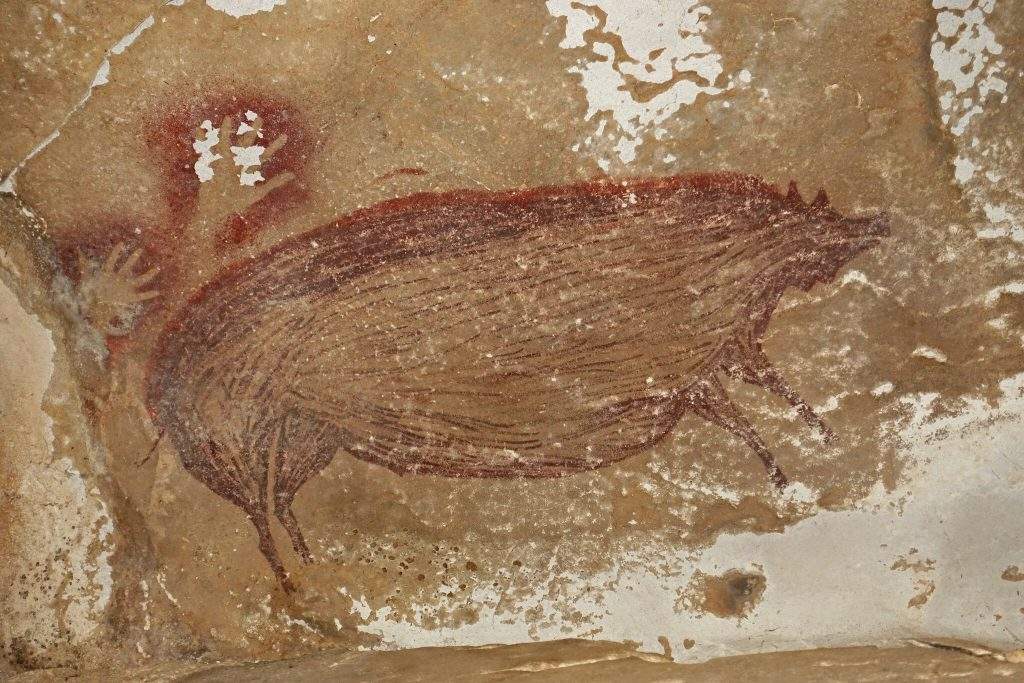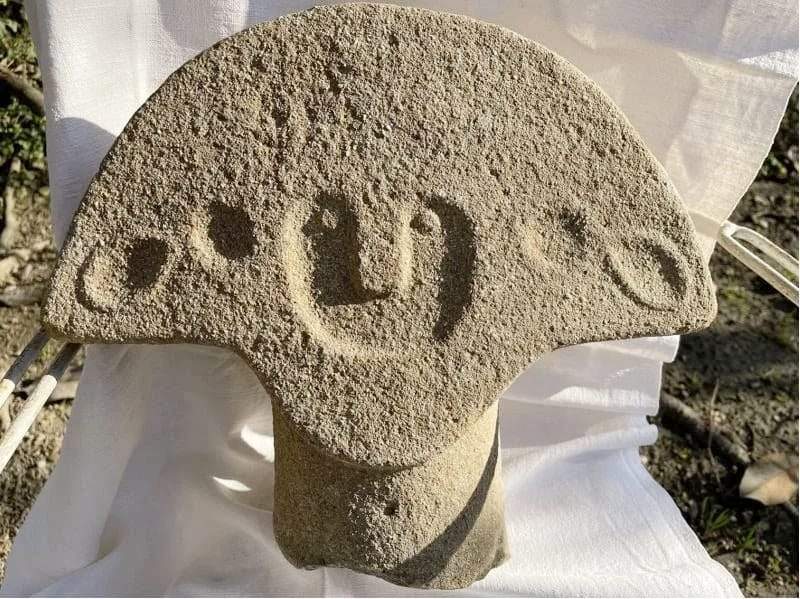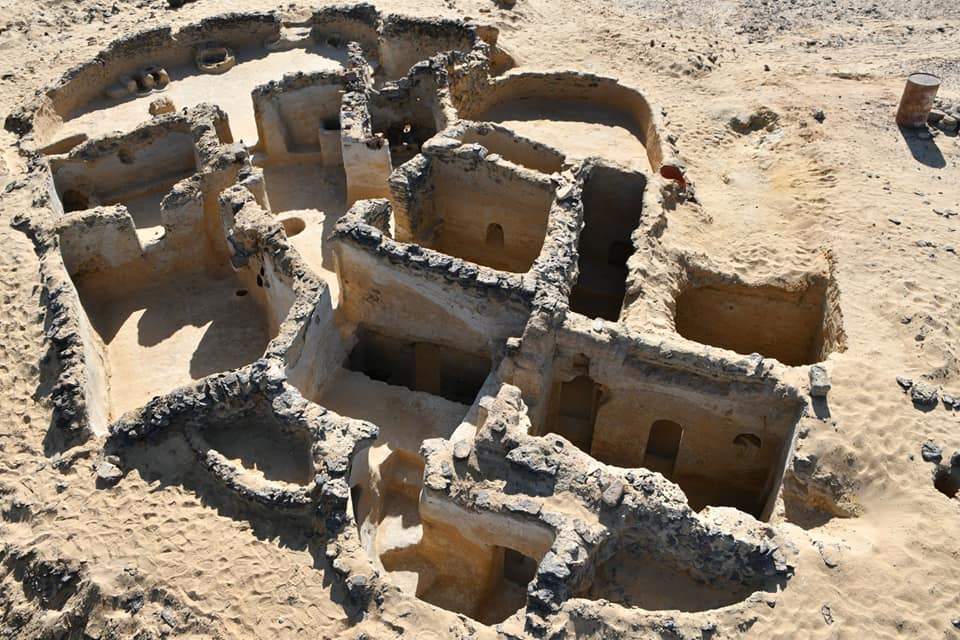The year 2021 was also a year of archaeological discoveries, all over the world. Which were the most interesting, the most important, the most discussed, the most exciting? We have selected ten: here are what they are. In strict chronological order.
We begin the year from rock art with a discovery that comes from Indonesia, where some hunting scenes considered the oldest of their kind in the world, dating back some 44,000 years, had already been found at the end of 2019. Two painted animals of the Celebes boar species (Sus celebensis) have been found in Sulawesi, one of which has been dated to 45,500 years ago. The pig was found in the Leang Tedongnge cave (a cave located in an impassable area of Sulawesi, accessible only in the dry season and after a long hike through the mountains, in the middle of the rainforest): made with ochre pigment, it is in a fair state of preservation. Read the full story here.

Between September and October 2020 (but the news was not released by Greece’s Ministry of Culture until January 19, 2021), a team of archaeologists from the Ephorate of Marine Antiquities (a counterpart of our Superintendency of Underwater Heritage) found in the sea around the island of Caso (in the southern Aegean, between Crete and Rhodes) a Roman-era shipwreck laden with amphorae. The discovery emerged as part of a campaign that focused precisely around the island of Caso (Kasos in Greek) and led to the discovery of three other wrecks in all, from different eras, the oldest of which dates back to the fifth century B.C. These are other ships carrying amphorae, but the most interesting one is the Roman ship from the second-third century. Read the full story here.

In France, the Institut National de Recherches Archéologiques Préventives (INRAP, National Institute of Preventive Archaeological Research) has made an important discovery in Nîmes, Occitania: in the city’s historic center, in the quarter that corresponds to the forum of ancient Nemausus (this was the name of Nîmes in Roman times), about a hundred meters from the Maison carrée (symbol of the ancient city), two rich domus from the imperial age have been found. A valuable opus sectile floor was also found in one. Read the full story here.

An extraordinary archaeological find in the province of Massa and Carrara. In fact, a stele statue head in excellent condition was found in Pontremoli, near Mount Galletto. It was discovered by a citizen of Carrara with Pontremoli origins, Paolo Pigorini, who had noticed a bizarrely shaped rock, left by a farmer at the edge of a vegetable garden along with a pile of stones resulting from the preparation of soil for plowing. Pigorini reportedly picked up the rock and, recognizing that it was the head of a stele statue, handed it over to the director of the Pontremoli Museum of Stele Statues, Angelo Ghiretti, who recognized the work as an authentic Copper Age artifact and alerted the superintendence official, Marta Colombo, and Pontremoli Mayor Lucia Baracchini. Read the full story here.

A French-Norwegian archaeological mission, led by the Institut français d’archéologie orientale, revealed over the weekend that it has discovered the oldest known Christian monastery in Egypt. The site was found in the Bahariya oasis in the middle of the desert, a distance of about 370 kilometers from the capital Cairo. “The French-Norwegian mission,” Egypt’s Ministry of Antiquities explained in a statement released Saturday, “discovered, during its third excavation campaign at the site of Tal Ganoub Qasr-al Agouz in the oasis of Bahariya, many buildings built of basalt, others carved in rock and others made of clay bricks.” Read the full story here.

A Roman-era necropolis from the 3rd-4th centuries AD has been discovered in Corsica, near the town of L’Île-Rousse in the north of the island. The necropolis emerged from a preventive archaeological excavation carried out in anticipation of some real estate projects in the center of the town. The discovery is important because prior to this find there had been no significant discoveries in this area of Corsica: finds near L’Île-Rousse were rare and fragmentary, and consequently this necropolis of considerable size for the context could suggest that there were significant settlements in the area. Read the full story here.

During excavation activities in the Segesta Archaeological Park, the Scuola Normale Superiore di Pisa found a monumental building in the area of the portico that closed the ancient agora. At the end of the excavation work, directed by Anna Magnetto, Maria Cecilia Parra (professor of Archaeology of Magna Graecia and Ancient Sicily, University of Pisa) and coordinated in the field by Riccardo Olivito (IMT researcher from Lucca), under the supervision of the Director of the Segesta Archaeological Park, Rossella Giglio, relevant results were highlighted, evidence of the importance that munificence held in Greco-Roman society between the 2nd and 1st centuries BC. Carmine Ampolo, Professor Emeritus of the Normal School, was also present to study the epigraphic material and historical aspects.Read the full story here.

In Iraq, a team of Russian archaeologists from the Institute of Archaeology of the Academy of Sciences has discovered a 4,000-year-old city that may be the ancient capital of a kingdom formed following the political upheavals that marked the end of the Paleo-Babylonian period. The city is located in Dhi Qar Governorate, and specifically in the Tell al-Duhaila area, an area once occupied by Sumerians (this is where, for example, the Ziggurat of Ur is located). “The excavation,” recounted archaeologist Alexei Jankowski-Diakonoff (head of the mission), “began in April 2021 and represented the first full cycle of archaeological field research in southern Mesopotamia.” Read the full story here.

In England, on the outskirts of Newcastle, in the north of the country, further remains of Hadrian’s Wall, the great fortification, a UNESCO World Heritage Site, built in the first century A.D., that marked the boundary between the Roman province of Britain and Caledonia, or the territory, corresponding largely to present-day Scotland, inhabited by the Caledonians, have been discovered. The discovery was announced by the Northumbrian Water company, which manages Newcastle’s water supply network: the discovery was in fact made in a busy and busy area of the city during some maintenance work. Read the full story here.

A team of archaeologists working for the Archaeological Office of the Canton of Valais (Switzerland) discovered, during a preventive excavation for a construction in the commune of Saint-Léonard, at Les Fougains, an alignment of 13 medium-sized menhirs (they are just over a meter high), which may date back to the Bronze Age or Neolithic (carbon-14 dating is currently underway to get more precise information). Menhirs are large stones that were hoisted upright by ancient peoples who lived during the Neolithic: they could be erected individually or in groups and were used for religious purposes. Read the full story here.

 |
| The 10 most interesting archaeological discoveries of 2021 |
Warning: the translation into English of the original Italian article was created using automatic tools. We undertake to review all articles, but we do not guarantee the total absence of inaccuracies in the translation due to the program. You can find the original by clicking on the ITA button. If you find any mistake,please contact us.